Antipyretics for children are prescribed by a pediatrician. But there are emergency situations for fever when the child needs to be given medicine immediately. Then the parents take responsibility and use antipyretic drugs. What is allowed to give to infants? How can you bring down the temperature in older children? What medicines are the safest?
Abdominal hernia is a fairly common disease that can occur in any person. It is divided into many types that have various symptoms, location, causes of development and treatment tactics. The disease brings a lot of discomfort to a person’s life, so it is important to know what a hernia of the abdomen is.
Our readers are health conscious and tend to try new things. These are people with an open mind. Knowing this, the famous doctor Molchanova Olga advised our readers to try a new gel for pain in the joints Pantagor, which, in studies, showed results are much higher than Voltaren. We will not hide the results of using the drug, we were surprised. In order not to be unfounded, we recommend first.
A hernia on the abdomen is a disease characterized by the protrusion of organs abdominal cavity on the surface of the abdomen or by directing them through the hernial ring into the abdominal cavity. Hernial gates are clearings that have arisen in the wall of the abdomen. This defect is of natural origin or may be formed due to injury or surgical intervention.
As statistics show, different types hernias in the abdomen suffer about 5% of the population. The vast majority of them (80%) are men, and the remaining 20% are women and children. As a rule, abdominal hernia is diagnosed in preschoolers and people over 50 years old.
Diseases have types, including abdominal hernia. The classification is very extensive and includes a huge number of subspecies. For clarity, let's make a table.
| signs | Types of hernias |
| Location |
|
| Localization |
|
| Hernia incarceration |
|
| Volume |
|
| Special types |
|
Internal abdominal hernias are diagnosed in 25% of cases. In all other situations, patients suffer from outward appearances. Also special attention deserves a ventral hernia. Recently, she began to meet more often. Ventral hernia occurs after surgery.
Causes and symptoms
Abdominal hernia does not appear spontaneously. It takes time and several pathological factors to occur. Causes are divided into 2 types: disposing and accomplishing.
The available ones include:
- hereditary factor;
- congenital weak muscles;
- the resulting changes due to injuries, surgical interventions, exhaustion, after which weak points appear on the body.
Accomplishing causes provoke an increase in intra-abdominal pressure and the development of a hernia of the anterior abdominal wall at weak points. Among them are:
- regular heavy physical exercise;
- excess weight;
- tumors of organs located in the abdominal cavity;
- persistent cough that occurs with chronic lung diseases;
- disturbed urination;
- persistent constipation;
- pregnancy, difficult childbirth;
- some diseases (tuberculosis, cirrhosis, enlarged prostate, paralysis of the legs, poliomyelitis, etc.).
All of the above causes that cause the appearance of pathology should last for a long time. Only then is a hernia of the anterior abdominal wall formed. 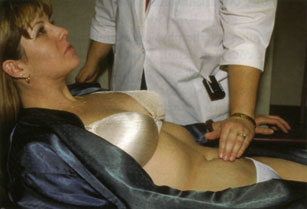
Symptoms of a hernia of the abdomen manifest themselves in different ways.
All types are characterized by a feeling of discomfort, soreness and protrusion, which takes place in a horizontal position. When observing these symptoms, you should see a surgeon. He will conduct the necessary examinations and make the correct diagnosis.
When a hernia forms in the abdomen, the symptoms depend on its location and severity. Signs of a hernia of the abdomen are as follows:
- A protrusion in the form of a tumor that appears with any physical exertion.
- Aching and drawing pains in the region of the hernia.
- Urinary disorders.
- Various digestive disorders - bloating, diarrhea, constipation, vomiting, nausea, constant belching.
Diagnosis of the disease
If you suspect the pathology of "abdominal hernia", the corresponding symptoms are observed, then you need to contact a specialist for comprehensive survey organism.
If the tumor forms in the usual places for hernias (groin, navel and thigh), the disease is easily diagnosed. Ventral hernia is recognized by the "cough push". It is necessary to put a hand on the protrusion and ask the patient to cough, while clear tremors should be felt. Diagnostic methods include palpation of the hernial orifice, palpation and tapping of the tumor.
For some types of hernias of the anterior abdominal wall, additional methods are used:
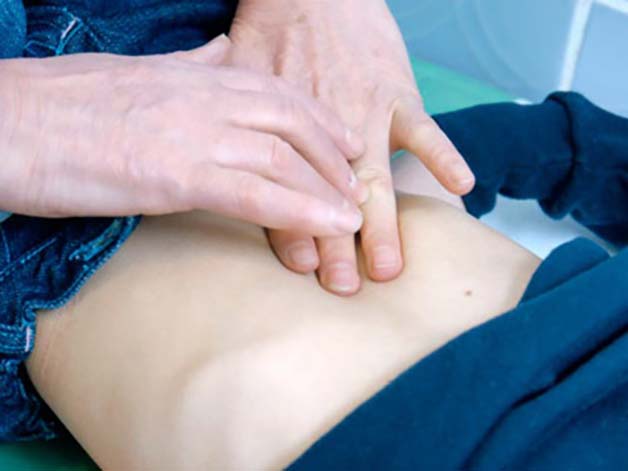
Methods of treatment
Very rarely, a ventral abdominal hernia disappears with conservative treatment. Surgery is almost always required. If there has been an infringement internal organs, then the operation is carried out urgently. Below we consider in more detail all the methods of treatment.
conservative methods
Conservative treatment of abdominal hernia is prescribed in order to prevent complications, tumor growth and alleviate symptoms. It is used in relation to patients for whom surgical intervention is contraindicated due to age, pregnancy, serious illness.
Conservative methods include:
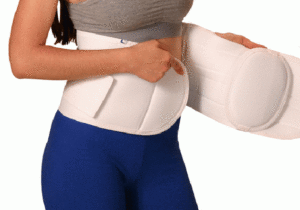
Surgical treatment
The only way to cope with the pathology is to remove the hernia of the abdomen through surgery.
Only one type of hernia can disappear on its own - it is umbilical in children under 5 years old. Other types, including ventral hernia, will not disappear on their own, moreover, over time they will increase in size and pose a serious threat to human health.
With the manifestation of the first symptoms, you should immediately consult a surgeon. A timely operation gives more chances for a quick recovery without various complications. Before the operation, the patient must undergo an examination and pass all the necessary tests. An analysis of the patient's health will allow the surgeon to prescribe the appropriate treatment option.
As a rule, a hernia of the abdomen is removed using hernioplasty. In total, there are 3 ways to carry it out:
- Tension (the hole at the site of the removed hernia is tightened by its own tissues).
- Without tension (to close the hole, polypropylene mesh implants are used).
- Combined (use both mesh and own fabrics).
Usually resort to the second method. It does not stretch fabrics, and the polypropylene mesh provides reliable protection that can withstand significant loads. 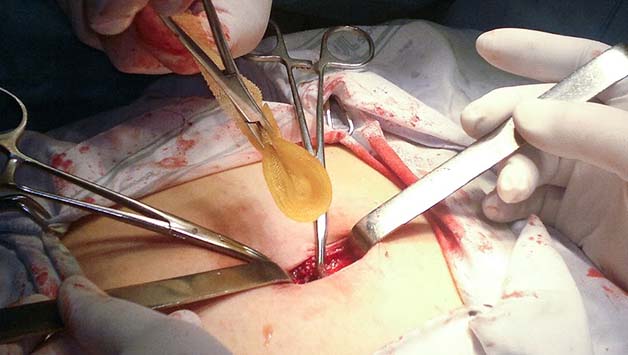
Also, an operation to remove a hernia can be performed by open, laparoscopic and endoscopic methods:
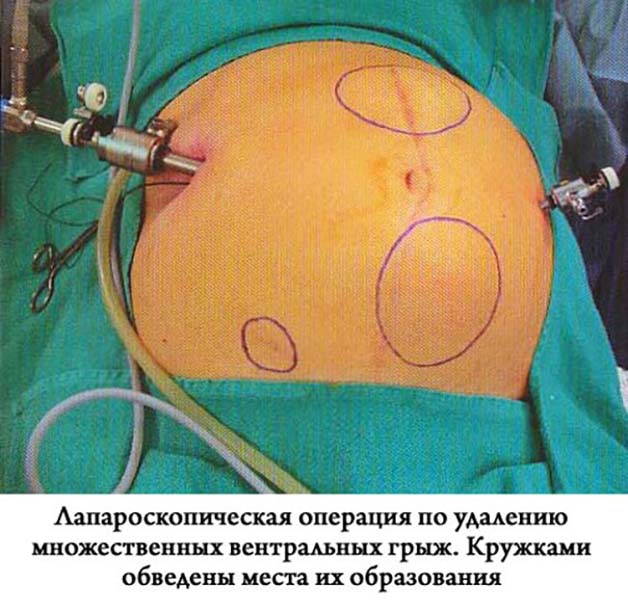
Postoperative recovery
Rehabilitation consists in restoring the strength of the patient's body. Recommendations depend on the method of the operation, they must be prescribed by a doctor. After examining the patient, he prescribes a diet, postoperative therapy and determines the intensity of exercise.
10 days the patient must go to the hospital to perform dressings. In addition, assigned drug treatment painkillers and antibiotics. Physiotherapy courses will help speed up the recovery process.
You can't play sports for a few months. You also need to follow proper nutrition. In the first days after the operation, it is necessary to eat liquid food: broths, light soups, kissels. Gradually, cereals, lean meats and fish, eggs, vegetables, fruits, and seafood should be added to the diet. It is necessary to give up salty and spicy foods, smoking, drinking alcoholic beverages. 
The stitches are removed after a week. After that, it is recommended to wear a bandage to restore tone to the abdominal muscles. After 3 months, you can do light physical education, while the bandage can not be removed. Breathing exercises and regular massage contribute to a quick recovery.
Abdominal hernia is a serious disease that requires treatment. Otherwise, serious complications may occur in the form of peritonitis, intestinal obstruction, intoxication.
Surgeons know and can explain why abdominal hernia occurs in women. The organs of the abdominal cavity are externally covered with a parietal sheet of the peritoneum. With a hernia, the peritoneum comes out through the weak points of the abdominal wall. It manifests itself in the form of a protrusion. Most often, a hernial defect is detected in the area of the white line of the abdomen and navel.
Abdominal hernia is a pathological condition in which there is a protrusion of organs through the front wall of the abdomen. In women, this pathology develops less frequently than in men. This is due to the fact that males experience great physical exertion. The incidence rate is 1 case per 100,000 women. The risk group includes women over 45 years of age.
All hernias in the abdomen can be divided into 3 types:
- umbilical;
- postoperative;
- white line;
- inguinal.
This defect is congenital and acquired. Depending on the location of the hernial sac, complete and incomplete hernias are distinguished. The hernial defect can be reduced and unreduced. By clinical manifestations isolated complicated, uncomplicated and recurrent hernia.
Etiological factors
The appearance of a hernial defect is due to various factors. There are the following reasons for this condition:
- congenital weakness of the abdominal muscles;
- weight lifting;
- difficult working conditions;
- the presence of chronic constipation;
- overweight;
- decrease in tissue elasticity;
- trauma;
- accumulation of fluid in the abdominal cavity;
- respiratory diseases accompanied by a strong cough.
A postoperative hernia appears when the doctor's recommendations are not followed after the operation and the wound is not properly sutured. A predisposing factor may be severe depletion of the body. chronic diseases digestive organs also increase the likelihood of developing this pathology. The basis of the appearance of a hernia in a woman is an increase in pressure in the abdominal cavity.
Symptoms
Symptoms depend on the type of hernia. If the defect is formed in the region of the white line of the abdomen, then the following symptoms may appear:
- swelling mainly in the upper abdomen;
- soreness;
- nausea;
- vomiting;
- pain.
Soreness is determined by palpation. The pain is localized in the area of the location of the white line of the abdomen. It intensifies when a person moves and works. Pain can be felt in the hypochondrium, lower back or shoulder blades. Additional symptoms include heartburn, belching, and bloating. Most often, the defect is small.
In most cases, it is single. More rarely, several hernias form at once. In the hernial sac there may be loops of the intestines, stomach, omentum. The defect is located above the navel or below it. When the contents of the hernial sac are infringed, the symptoms intensify. This condition is an emergency and requires surgery.
When infringed, the pain becomes sharper and more intense. Symptoms often include nausea, vomiting, blood in the stool, constipation, and abdominal pain. In case of infringement, there is a risk of soft tissue necrosis due to circulatory disorders and compression of the contents of the hernial sac. Very often an umbilical hernia is detected. It is characterized by the following symptoms:
- protrusion of the hernial sac;
- nausea;
- vomiting.
The temperature in the absence of complications does not increase. If the process involves bladder, then women complain of urinary incontinence. Sometimes this pathology is diagnosed during the bearing of the baby. In pregnant women, a rounded formation near the navel and characteristic clicks in the abdomen can be detected. Rumbling, lack of stool for several days, nausea - all these are signs of intestinal obstruction.
With an inguinal hernia, symptoms appear gradually. An increase in the hernial defect contributes to an increase in pain. Pain is felt on the left or right. She is one-sided. With an inguinal-scrotal hernia, an increase in the volume of the scrotum is observed. An uncomplicated hernia may repair on its own. This cannot be done if it is infringed.
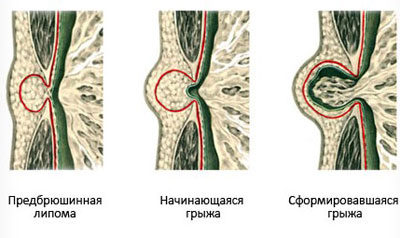
Help
Treatment of patients is carried out after the exclusion of other pathologies. Ultrasound and x-rays are required. In severe cases, laparoscopy may be required. The main method of therapy is surgery. Treatment without surgery is ineffective. If there are contraindications to surgery, then patients should wear a bandage.
With a hernia without complications, a planned operation is performed, with a strangulated hernia, an emergency surgical intervention is performed.
Allocate plastic in a natural way and with the help of artificial materials. The use of synthetic agents is the most modern method of treating sick women. Laparoscopic surgery is often performed.
Before reduction of the hernia, an examination of the organs that make up the hernial sac is carried out. If tissue necrosis is detected, it is excised. With the development of purulent complications, antibiotic therapy is performed. IN postoperative period patients should limit physical activity, diet and wear a bandage.
When placing mesh implants, the bandage should be worn for about a month. Surgical sutures are removed after 7 days. After the operation, women can get up the next day. It is forbidden to lift weights and strain the abdominal muscles. You need to get out of bed slowly, first turning over to one side. In the absence of complications, the working capacity of women is restored.
Even after successful treatment, relapses of the disease are possible. They are observed in 3-5% of patients. Infringement of a hernia can lead to the following complications:
- peritonitis;
- acute intestinal obstruction;
- tissue necrosis;
- phlegmon;
- perforation of the intestinal wall.
Sometimes complicated hernias cause the death of patients. Thus, the appearance of a hernia in women is most often due to high physical activity. Treatment should be provided in the first days after the formation of a hernia and the onset of pain.
The hernia usually manifests itself in different ages and the reasons can be very diverse - pregnancy, the presence of extra pounds and so on. Such a pathology can occur even in absolutely healthy women engaged in heavy physical labor or sports power loads. These processes have specific symptoms, which manifest themselves clearly only with serious complications of the hernial defect, so the first stage of the deviation may not be detected immediately. Discomfort in the abdominal cavity, bulging of some organs and palpation of a defect are the first signs that should be alarmed when found.
Our readers are health conscious and tend to try new things. These are people with an open mind. Knowing this, the famous doctor Molchanova Olga advised our readers to try a new gel for pain in the joints Pantagor, which, in studies, showed results are much higher than Voltaren. We will not hide the results of using the drug, we were surprised. In order not to be unfounded, we recommend first.
A hernia of the abdominal region is a serious pathological condition, as a result of which parts of some organs move into the adjacent cavity or subcutaneous zone of the abdomen. Such a protrusion most often manifests itself in the navel or the white line of the press. In the female, this defect occurs less frequently than in men, since the stronger sex is more susceptible to power loads. However, this pathology also occurs in women, and women over the age of 45 are usually at risk.
Important! Ignoring this disease, over time, an increase in its size is observed, dysfunction of internal organs occurs, and severe manifestations are: bleeding, necrosis, ischemia and oozing perforations, accompanied by pain.
Causes of the disease
The expression of a hernial defect may be due to various factors, among which the most common are distinguished:
- Infectious diseases accompanied by a dry aggressive cough;
- Congenital weakness of the muscle tissues of the abdominal zone;
- Pathological accumulation of excess fluid in the abdomen;
- Systematic and excessive power loads;
- All kinds of injuries, postoperative complications in case of non-compliance medical advice;
- Difficult conditions of physical labor;
- Decreased elasticity of muscle tissue;
- The presence of excess weight;
- Pregnancy;
- Chronic constipation.
In fact, there are many more determining factors for the manifestation of such an anatomical defect, and some of them are even unknown to science.
The cause of the occurrence can also serve as a bad lifestyle - smoking, drugs, alcohol.
Symptoms of a hernia
At the initial stage of the birth of pathology, visible symptoms, as a rule, are not observed, since the disease declares itself, having fully formed. Each of the varieties of the anomaly manifests itself in its own way, however, the general symptoms of such a disease are known:
- In the center line of the abdominal cavity, an unknown swelling is observed with the naked eye, which is felt on palpation. When applying the palm to this area, during severe cough characteristic shocks are observed;
- In the focus of education, women experience pain that increases after a heavy meal or physical exertion;
- Painful sensations from the immediate site of localization may slightly radiate to the rib, lumbar or a spatula;
- In addition to the fact that the neoplasm hurts, it is also accompanied by constant dyspepsia;
- Often, when a hernial sac occurs, hemorrhage in the feces, nausea, heaviness and vomiting are observed.
Soreness is also established during the period of palpation, and additional symptoms can be sudden heartburn, bloating, or frequent belching. If the neoplasm is infringed, the painful symptoms can increase significantly, which is a very urgent phenomenon and requires immediate surgical intervention. With a slight infringement of the hernial formation, the pain becomes intense and sharp, and there is a possibility of soft tissue necrosis. The determining reason for this is the violation of blood flow and direct squeezing of the contents. In some, more advanced cases, an increase in temperature is observed.
Types of abdominal hernia
Against the background of stretching the weakened white line of the press, small cracks appear. Varieties of abdominal hernia in women are differentiated depending on what exactly protrudes from them. With a preperitoneal lipoma, bulging of fat is visible, with a protrusion that occurs, the formation of a hernial sac is observed, and already in the formed hernial sac, abdominal organs can be located. In medical practice share several varieties of hernia.
umbilical
In this case, there is an exit of a part of the internal organ beyond the abdominal septum through the umbilical opening. Usually these organs are a small fragment of the small or large intestine, omentum and other organs. It is not easy to detect detections in the early stages, but after a certain period, as it develops, the deficiency can be determined with the naked eye. Today it is the most common problem, even in newborn girls. As for adult women, the pathology manifests itself closer to forty years, due to the gradual depletion of the umbilical ring and the weakening of the connective tissues. 
inguinal
Here, a partial exit of the internal organs is carried out through the inguinal canal - this is a paired slit-like formation in the lower part of the abdominal septum, inside which there is a round weaving of the uterus. With such a defect, bowel loops, parts of the fallopian tubes, the ovary, bladder, omentum, and in some cases the ureter and spleen usually bulge outward. Female inguinal hernia is most often an acquired phenomenon, however, congenital forms also occur in medical practice, and as a rule, can be one- and two-sided. 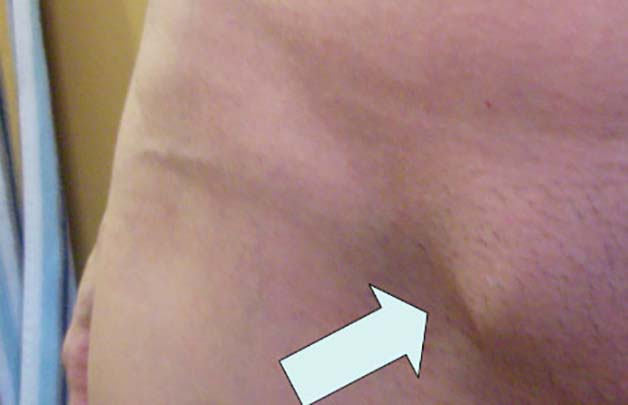
Postoperative
The manifestations of this anatomical defect are due to improper patient care, early and excessive physical exertion after surgical manipulations, as well as ignoring medical recommendations. The defect usually forms at the site of the laparotomy, in the area of the white line, but can also occur anywhere else. The most frequent localizations of the disease are usually various scars of surgical intervention on different bodies small pelvis, removal of the hepatic cyst and sutures after cholecystectomy. Distinctive features of the occurrence of postoperative hernias are the cause of their appearance, and this is an operation. 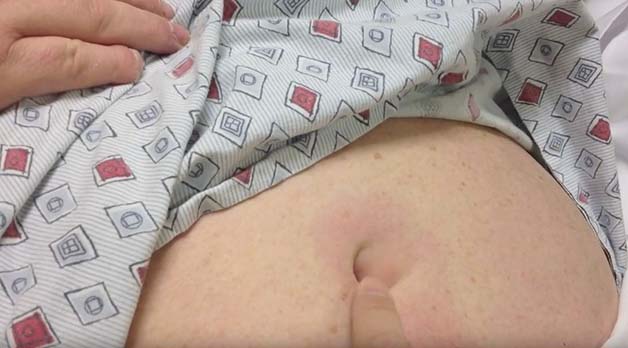
white line
A hernia of the abdomen in women in the region of the white line is a subcutaneous growth on the abdominal septum, in its anterior part. This zone consists entirely of muscles, however, in the very center there is a narrow area in which muscles are absent. This connection is recognized as the white line of the press, the width of which is rather uneven - it is narrower at the bottom than at the top. Usually, such a pathology is formed from fatty deposits, however, in some cases, depending on the center of localization, it can capture fragments of some internal organs of the abdomen. 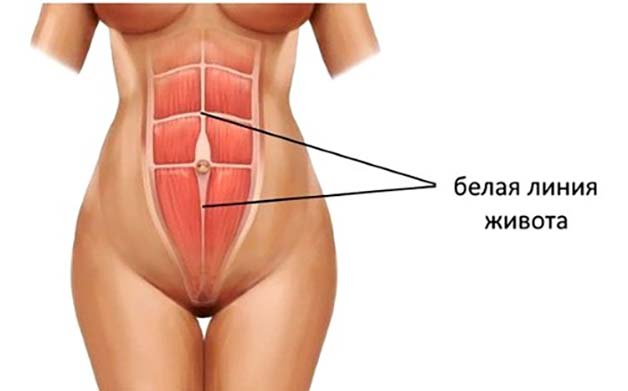
congenital
Such a protrusion is an anomaly from birth, and can occur both independently and accompanied by other pathologies. Most often, particles of the omentum, intestinal loops, rounded uterine ligaments, fragments of the bladder, and so on, enter the zone of the inguinal sac. Defectiveness appears immediately after birth, and the first cause of concern for parents should be the discovery of a tubercle in the groin area, of unknown origin. This is a kind of oblong swelling, directed along the inguinal canal. 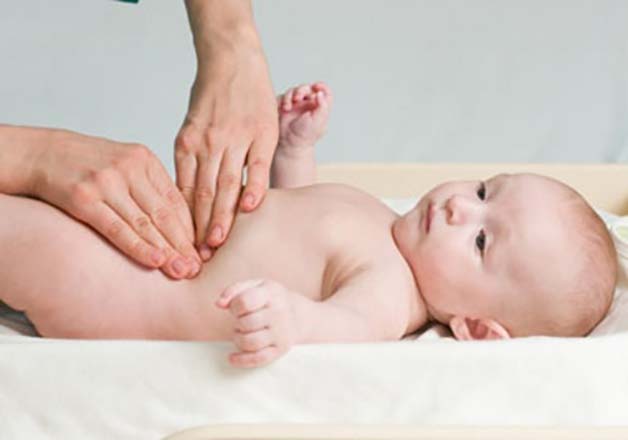
According to their clinical manifestations, these classifications of hernial anomalies can be well-established and complicated. It can be diagnosed by the presence of an aggressive inflammatory process, ischemic disorders, trauma, squeezing and manifestations of other severe consequences.
Hernia therapy in women
You can get rid of the disease only by surgery, and this is: tension and non-tension hernioplasty or laparoscopic surgery.
The open plastic method is gradually becoming a thing of the past, as it is accompanied by the presence of large scars, as well as by many other criteria. The advantages of laparoscopic surgery are:
- To remove the hernial formation, three small punctures are required, in which case there is no significant injury to the muscles of the abdominal cavity;
- The postoperative period proceeds much easier and faster, there is a rapid correction, the absence of pain manifestations and poor healing of the sutures;
- The recovery period is significantly reduced, but periodic preventive maintenance is not excluded;
- Disappear in about seven days unpleasant symptoms, and after 8-10 days, light physical labor is possible.
The distinctive features of hernioplasty are: the postoperative period is twice as long as with laparoscopy, the presence painful symptoms after surgery, the risk of recurrence of the anomaly is also doubled, traces after surgery are observed about 10 cm, despite the fact that in the other case there are only three imperceptible points. Despite all the advantages of the laparoscopic method, the method of treatment is determined based on the individual characteristics and general condition of the patient.
Remember! Sometimes ignoring the disease and its complications can lead to irreparable consequences and often end in death.
Therefore, it is extremely important to diagnose the pathology in time and take all necessary medical measures. Treatment must be carried out at the first stages of the manifestation of the anomaly.
Abdominal hernia in women is a pathological migration of organs or their individual parts through a congenital or acquired anatomical defect in the muscles and ligaments of the peritoneum. Over time, there is an increase in the size of the pathology, which leads to complications. The disease affects mainly children and the elderly.
Structure
In the formation of a hernia, three components are distinguished:
- Hernial orifice - an opening in muscle layer through which, under the influence of various provoking factors, internal organs protrude. Gates come in different diameters and shapes (oval, round, slit-like).
- The hernial sac is a part of the peritoneum (adipose tissue) that holds the internal organs that have gone beyond their limits.
- Hernial contents - it includes intestinal loops, bladder, omentum, uterine appendages, uterus, kidneys, spleen and other organs.
Without medical intervention, the pathology does not go away, the lack of treatment aggravates the course of hernias. When the first signs of illness appear, you should seek medical help as soon as possible.
Disease classification
Hernia in women in the abdomen differs in anatomical, etiological, clinical signs.
Anatomy
According to the medical classification, the following types of illness are distinguished:
- Umbilical - in women, congenital and acquired types of pathology occur. The disease is accompanied by the exit of internal organs through the umbilical ring, which in healthy person grows in the womb. Acquired hernias appear after different reasons. These are heavy physical exertion, weakness of the abdominal muscles, the period of pregnancy and other provoking factors.
- Femoral - located in the corresponding area, slightly below the crease of the groin. With minor pathologies, the femoral artery and nerve become hernial contents. If the protrusion reaches a large size, intestinal loops and some organs of the peritoneum suffer.
- Inguinal - a common type of abdominal hernia, more common in men. Pathology develops in the relevant area, has several types, in women the congenital form of the disease predominates.
- Diaphragmatic - are defects in the diaphragm, which cause the migration of internal organs into chest. Diaphragmatic hernias are divided into traumatic and congenital.
- The white line of the abdomen is a defect in the muscles and ligaments of the indicated area. This name has the anterior part of the human peritoneum, consisting mainly of connective tissue.
By etiology
Depending on the etiological signs, there are:
- Congenital - diagnosed immediately after the birth of a child or after a while. Pathology occurs in umbilical and inguinal formations.
- Acquired - arise under the influence various factors in the process of human life.
- Postoperative - ventral hernias, relevant after surgical procedures in the abdominal region. This type is the cause of the divergence of the seams and the recurrence of the pathology.
- Education that occurs after the transfer various diseases(neuropathic hernia).
The first place among all types is occupied by congenital formations. Acquired protrusions are diagnosed much less frequently.
According to clinical manifestations
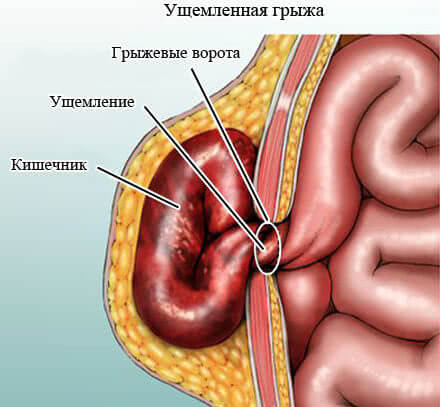 The disease has several clinical features:
The disease has several clinical features:
- Reducible - an uncomplicated violation in which the hernial contents are freely reduced to their anatomical place.
- Irreducible - arise due to the formation of adhesions, the contents of the bag cannot be returned to the peritoneum area on their own.
- Not restrained - characterized by the absence of compression of the organs that have fallen into the hernial opening.
- Strangulated - a dangerous type of complication, the result of which is the compression of internal organs with impaired blood circulation and the development of the risk of tissue death.
Strangulated hernias are divided into retrograde, elastic and parietal. The first type is accompanied by compression of several intestinal loops at once, while the intermediate loop is located in the abdominal cavity. Elastic means compression of one loop or part of it. Parietal - this is the compression of a certain zone of the intestinal wall.
Symptoms
How does a hernia of the abdomen hurt in women? The disease manifests itself in different ways, which is determined by the location of the protrusion:
- pain is observed at the site of the hernia;
- externally manifested by a rounded or oblong protrusion on the abdomen, in the groin or other area, invisible when the body is horizontal;
- pressure on the area of education is accompanied by a characteristic intestinal rumbling;
- significant sizes cause digestive problems (nausea, flatulence, vomiting, belching, defecation disorders);
- women with inguinal hernia are diagnosed with severe pain during menstruation.
With complications, infringement is manifested, leading to symptoms such as intense pain in the area of \u200b\u200bthe pathology. The patient develops anxiety, heart rate increases. Body temperature may rise at the site of the protrusion, and general fever is often noted. Later, signs of intestinal obstruction develop. There is no stool or, conversely, diarrhea occurs. Some patients have difficulty urinating.
If the above symptoms appear, you should immediately seek medical help.
Causes
Abdominal hernia in women can occur under the following circumstances:
- weakness of the muscles of the peritoneum;
- connective tissue pathology;
- anatomical aging of the body;
- sudden weight gain or loss;
- accumulation of fluid in the abdominal cavity;
- multiple pregnancy, polyhydramnios;
- frequent physical overstrain;
- diseases accompanied by prolonged cough, constipation, vomiting;
- labor activity associated with lifting heavy objects.
Often the disease develops against the background of surgeries and injuries of the peritoneum. Internal hernias are formed due to abnormal intrauterine development of the fetus.
Diagnostics
The diagnosis is made on the basis of clinical laboratory data and instrumental diagnostic methods. For this use ultrasonography, x-ray, endoscopy, computed and magnetic resonance imaging.
Differential diagnosis is carried out with pathologies of a tumor nature, which are most often located in the places where abdominal hernias form. It excludes benign and malignant tumors, enlarged The lymph nodes, tuberculous suppuration and other diseases with similar symptoms.
Therapy Methods
Treatment of pathology is carried out mainly by surgery. This is the only way to completely get rid of the disease. Conservative therapy used in cases of serious contraindications to the operation and formations of small diameter.Operation types
Surgical disposal of a hernia of the abdomen is carried out in several ways. These include open surgery and the laparoscopic method. The latter is carried out with the help of several punctures, through which microscopic instruments and video equipment are introduced into the operated area, allowing you to monitor the progress of the operation.
An open type of surgical intervention is performed through an incision that provides direct access to the formation. The disadvantages of this type of surgery include significant damage to the patient's tissues, the need for numerous sutures, the presence of scars after the intervention, pain and a long recovery period.
Laparoscopy is more modern method surgery, which avoids scarring of tissues, pain after treatment. The rehabilitation period takes from 7 to 14 days, the patient quickly returns to normal life.
Hernia repair techniques are as follows:
- Tension hernioplasty is the use of patient tissues that are sutured together using special techniques.
- Tension-free - to close the hole, implants in the form of a mesh are used.
- Combined plastic - the simultaneous use of both techniques.
An effective way to treat hernias in modern medicine considered a tension-free hernioplasty. The method is accompanied by the least number of relapses.
Conservative therapy
Non-surgical treatment consists in the implementation of a number of recommendations aimed at preventing complications and increasing hernias in size. To do this, the patient adjusts the lifestyle, adhering to the following rules:
- Eating a fiber-rich diet can help prevent constipation, flatulence, and other digestive problems.
- Refusal to lift weights, power sports, intense physical exertion.
- The use of compression underwear and special supporting bandages.
- Strengthening the muscles of the abdominal cavity with the help of massage and therapeutic exercises.
- Rejection of bad habits.
A conservative solution to the problem requires considerable effort and patience. With formations of large sizes, it turns out to be ineffective. A positive prognosis for the patient is given by the operation to excise the hernia and the careful implementation of the doctor's recommendations during the rehabilitation period.
Abdominal hernia is a prolapse of internal organs or their parts through a pathological congenital or acquired hole in the muscular wall of the peritoneum. This protrusion is usually covered by the parietal ventral sheet. Hernial formation tends to grow, reaching a huge size, and occurs most often in people in the elderly and children.
A pathological defect manifests itself with characteristic pain and the appearance of a tubercle in the abdomen.
This disease does not go away on its own, and no conspiracies and means traditional medicine cannot eliminate pathological protrusion. If the first signs appear, it is recommended not to hesitate to visit a doctor in order to prevent the development of complications of this disease.
How does it manifest
Signs of abdominal hernia vary according to the area of localization of the protrusion and the degree of progression of the disease. Among the main manifestations of the disease, the occurrence of bulge (swelling) can be distinguished. It is formed in the area of the umbilical ring, postoperative scar, midline of the abdomen or groin.
For self-identification of the pathological process, one should take horizontal position body, because a hernia on the abdomen appears only when the patient is standing or sitting, as well as when coughing, sneezing and straining.
In the prone position, the unimpaired protrusion is reduced independently. During the examination, it is elastic, mobile and has the ability to change shape.
A hernia of the abdomen has the following symptoms:
- projection pain in the localization area.
- The appearance of a feeling of squeezing and burning.
- Nausea, bloating may occur.
- In some cases it worsens general state the patient and there is a characteristic weakness.
If a hernial protrusion is formed in the lower abdomen, then a violation of urination is possible. The symptoms of abdominal hernia in women, men and children are basically the same. Girls and women can take the symptoms of a hernial protrusion as manifestations of another disease, the symptoms of which are unusual for men and children.
What are
The protrusions can be internal and external. External abdominal hernias are characterized by the protrusion of internal organs along with the abdominal parietal sheet. In this case, the hernial ring is formed in the muscular-aponeurotic layer of the abdominal wall, and the integrity of the skin is preserved. Internal abdominal hernias are distinguished by the fact that they are formed inside the peritoneum in the region of the abdominal folds and pockets or penetrate into the sternum cavity through acquired or natural cracks and apertures of the diaphragm.
In accordance with the international classification, the following types of hernias can be distinguished:
- Femoral - exit femoral artery, vein and nerve to the thigh area from the peritoneum. Usually this space is limited, but in some cases it is enlarged to such an extent that the intestine or other intra-abdominal organ penetrates into it. The bulge is located below the inguinal fold approximately in the middle of the femoral surface. This type of protrusion is most often diagnosed in women and has a high risk of becoming irreducible.
- Inguinal - occurs in 75% of cases of development of protrusion of the peritoneal organs and is diagnosed more often in men. The pathological process develops in the area of the transition of the femoral surface to the body. There are several types inguinal hernias, each of which has various mechanisms education.
- Umbilical - a widespread pathology, which is often determined in children after birth. This is due to the fact that the anatomical opening in the abdominal cavity, which should normally close before birth, remains open. If this hole is small, then the protrusion goes away on its own by about 2 years of age. If the hernia does not close on its own, then a planned surgical operation is prescribed at the age of 2-4 years. In adults, it can also develop due to weakening of the muscles of the anterior abdominal wall.
- Postoperative - after abdominal surgery, a defect remains in the abdominal wall. According to statistics, pathology develops in 2-10% of patients. Even after surgical treatment postoperative protrusions may reappear.

It is necessary to single out such a type of disease as a hernia of the Spigelian line of the abdomen, which is a protrusion in the region of the ilium. This type of pathological protrusion of the internal organs is very rare in both sexes with the same frequency.
A hernia of the oblique muscle of the abdomen is the development of a protrusion in the groin area. The prolapse of the internal organs occurs through the path along which, during the period of embryonic development in men, the testicles descended into the scrotal region. The descent into the scrotum of the hernial sac is diagnosed quite rarely.
Reasons for development
The etiology of the development of a hernial protrusion lies in congenital defects in the structure of the abdominal wall. Also, this disease can occur with the expansion of the muscle opening and thinning or loss of tissue elasticity. A wound or trauma to the abdominal wall can cause degenerative changes at the surgical incision line, which contributes to the formation of postoperative ventral protrusions.
The most pronounced predisposing factor for the occurrence of hernias in the abdomen is an increase in intra-abdominal pressure due to heavy physical labor, coughing, chronic lung diseases, difficulty urinating, pregnancy, prolonged constipation, abdominal tumors, ascites, obesity and flatulence.
Establishing diagnosis
To determine the hernia of the abdomen, you should go to an appointment with a surgeon or urologist. The doctor conducts an objective examination and evaluates the patient's complaints. It is mandatory to inspect the protrusion to determine its size and shape. A palpation examination is also performed to determine the degree of reducibility, the size of the opening of the inguinal canal.
As a more indicative diagnostic procedure using the cough method.
When coughing, the jerky pressure of the hernial contents on the tip of the finger, installed in the inguinal canal, allows you to get a more informative picture of the course of the disease. It is also recommended to undergo research activities such as auscultation and percussion, with which you can find out which organ is in the hernial sac.
Differential diagnosis of abdominal hernia eliminates the presence of diseases such as lipoma, abscess, inguinal lymphadenitis, hydrocele, cryptorchidism, varicocele and orchiepididymitis.
Complications of the disease
The most dangerous and frequent consequence of a pathological protrusion is a pinched abdominal hernia. With the development of infringement in the organ or part of it located in the area of the hernial sac, the blood supply stops. Strangulated hernia of the abdomen is accompanied by a characteristic pain syndrome, weakness and symptoms of intestinal obstruction, in particular, vomiting and nausea. In rare cases, body temperature may rise slightly.
Infringement is an indication for urgent surgical intervention. Untimely seeking medical help can cause the formation of intestinal gangrene. Some irreducible hernias are not incarcerated, therefore, if a bulge appears, you should consult a doctor for an accurate diagnosis and prescription. suitable treatment in each case individually.



